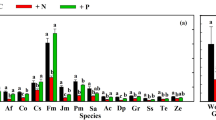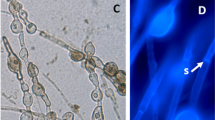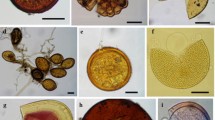Abstract
Phosphorus is the major nutrient limiting plant growth in a Costa Rican silvopastoral system located on an acid, high P-retaining, volcanic soil. We investigated plant responsiveness to vesicular-arbuscular mycorrhizal (VAM) inoculation using the leguminous tree species Erythrina berteroana Urban, and the two dominant grass species Paspalum conjugatum Berg and Homolepsis aturensis Chase of this silvopastoral system. We grew grass seedlings in the greenhouse for 15 weeks in a methyl bromide-sterilized study soil to which either mixed-species VAM inoculum (Theobroma cacao feeder roots) or autoclave-sterilized cacao roots (non-inoculated control) were added. E. berteroana was grown from both seedlings and vegetative stakes (40 cm long) for 30 and 19 weeks, respectively. Upon harvest, we measured above and below ground biomass, N and P content, root∶shoot ratio, legume nodulation, and VAM infection levels. The total above-ground and root biomass of mycorrhizae-inoculated P. conjugatum seedlings were 2.5 and 2.8 times greater than those of noninoculated seedlings. In contrast, VAM-inoculated seedlings of H. aturensis produced 8.4 and 5.9 times more total above-ground and root mass than noninoculated seedlings. Mycorrhizae-inoculated E. berteroana seedlings produced 10.6 times greater shoot biomass for inoculated versus noninoculated seedlings, while E. berteroana vegetative stakes exhibited a negative growth response to VAM inoculation (an approximately 16% decrease in shoot biomass for VAM-inoculated cuttings). The difference in responsiveness between Erythrina growth forms is hypothesized to reflect the cost-benefit relationship between plant host and fungal symbiont for energy and nutrient reserves.
Similar content being viewed by others
References
Abbott LK, Robson AD (1987) Managing VA mycorrhizal fungi in pastures. In: Sylvia DM, Hung LL, Graham JH (eds) Mycorrhizae in the next decade: practical applications and research priorities. Proceedings of the 7th North American Conference on Mycorrhizae. Institute of Food and Agricultural Sciences, University of Florida, Gainsville, Fla, pp 10–12
Ae N, Arihara J, Okada K, Yoshihara T, Johansen C (1990) Phosphorus uptake by pigeon pea and its role in crop** systems of the Indian subcontinent. Science 248:477–480
Barea JM, Azcón-Aguilar C (1983) Mycorrhizas and their significance in nodulating nitrogen-fixing plants. Adv Agron 36:1–54
Berbara RL, Freire LB, Lima LOA, Amaral Sobrinho NMB (1985) Infection micorrizica en ocho especies de leguminosas usadas como abono verde. Universidad Federal Rural do Rio de Janeiro, Rio de Janeiro, Brazil
Bethlenfalvay GJ, Brown MS, Newton WE (1987) Photosynthetic water- and nutrient-use efficiency in a mycorrhizal legume. In: Sylvia DM, Hung LL, Graham JH (eds) Mycorrhizae in the next decade: practical applications and research priorities. Proceedings of the 7th North American Conference on Mycorrhizae of Food and Agricultural Sciences, University of Florida, Gainsville, Fla, pp 231–233
Biermann B, Linderman RG (1981) Quantifying vesicular-arbuscular mycorrhizae: a proposed method towards standardization. New Phytol 87:63–67
Boerner REJ (1990) Role of mycorrhizal fungus origin in growth and nutrient uptake by Geranium robertianum. Am J Bot 77:483–489
Boerner REJ (1992) Plant lifespan and response to inoculation with vesicular-arbuscular mycorrhizal fungi. II. Species from weakly mycotrophic families. Mycorrhiza 1:163–167
Bolan NS, Robson AD, Barrow NJ (1987) Effects of vesicular-arbuscular mycorrhiza on the availability of iron phosphates to plants. Plant Soil 99:401–410
Borie F (1985) Fosforo orgánico y micorrizas “VA” en suelos volcánicos de Chile. Report Universidad de la Frontera, Temuco, Chile
Briceño JA, Pacheco R (1984) Métodos analíticos para el estudio de suelos y plantas. Universidad de Costa Rica, Centro de Investigaciones Agronomicas, San Jose, Costa Rica
Buwalda JG, Goh KM (1982) Host-fungus competition for carbon as a cause of growth depressions in vesicular-arbuscular mycorrhizal ryegrass. Soil Biol Biochem 14:103–106
Carling DE, Brown MF (1980) Relative effect of vesicular-arbuscular mycorrhizal fungi on the growth and yield of soybeans. Soil Sci Soc Am J 44:528–532
Chiariello N, Hickman JC, Mooney HA (1982) Endomycorrhizal role for interspecific transfer of phosphorus in a community of annual plants. Science 217:941–943
Clarkson DT (1985) Factors affecting mineral nutrient acquisition by plants. Annu Rev Plant Physiol 36:77–115
Collins Johnson N, Copeland PJ, Crookston RK, Pfleger FL (1992) Mycorrhizae: possible explanation for yield decline with continous corn and soybean. Agron J 84:387–390
Cooperband LR (1992) Soil phosphorus dynamics in a humid tropical silvpastoral system. PhD thesis, Ohio State University, Columbus, Ohio
Cuenca G (1993) Diversity of arbuscular-mycorrhizal fungi in cacao plantations from Northern Venezuela. In: Peterson L, Schelke M (eds) Abstracts of the 9th North American Conference on Mycorrhizae. University of Guelph, Guelph, Ontario, Candada, p 11
Cuenca G, Lovera M (1992) Vesicular-arbuscular mycorrhizae in disturbed and revegetated sites from La Gran Sabana, Venezuela. Can J Bot 70:73–79
Danso SK, Palmason F, Hardarson G (1993) Is nitrogen transferred between field crops? Examining the question through a sweet-blue lupine (Lupinus angustifolius L.)-oats (Avena sativa) intercrop. Soil Biol Biochem 25:1135–1137
Eissenstat DM, Graham JH, Syversten JP, Drouillard DL (1993) Carbon economy of sour orange in relation to mycorrhizal colonization and phosphorus status. Ann Bot 71:1–10
Fischer LE, Hetrick BA, Hartnett DC, Schwab AP (1993) Mycorrhizal-mediated interplant phosphorus transfer among tallgrass prairie species. In: Peterson L, Schelkle M (eds) Abstracts of the 9th North American Conference on Mycorrhizae. University of Guelph, Guelph, Ontario, Canada, p 12
Fitter AH (1977) Influence of mycorrhizal infection on competition for phosphorus and potassium by two grasses. New Phytol 79:119–125
Francis R, Read DJ (1984) Direct transfer of carbon between plants connected by vesicular-arbuscular mycorrhizal mycelium. Nature 307:53–56
Giovannetti M, Mosse B (1980) An evaluation of techniques for measuring vesicular arbuscular mycorrhizal infection in roots. New Phytol 84:489–500
Habte M, Manjunath A (1987) Soil solution phosphorus status and mycorrhizal dependency in Leucaena leucocephala. Appl Environ Microbiol 53:797–801
Hetrick BA, Kitt DG, Wilson G (1988) Mycorrhizal dependence and growth habit of warm-season and cool-season tallgrass prairie plants. Can J Bot 66:1376–1380
Huang RS, Yost RS (1987) Early physiological events in VA mycorrhizal Leucaena leucocephala. In: Sylvia DM, Hung LL, Graham JH (eds) Mycorrhizae in the next decade: practical applications and research priorities. Proceedings of the 7th North American Conference on Mycorrhizae. Institute of Food and Agricultural Sciences, University of Florida, Gainsville, Fla, p 253
Hung RS, Smith WK, Yost RS (1985) Influence of vesicular-arbuscular mycorrhiza on growth, water relations and leaf orientation in Leucaena leucocephala (Lam.) de Wit. New Phytol 99:229–243
Janos DP (1975) Effects of vesicular-arbuscular mycorrhizae on lowland tropical rainforest trees. In: Sanders FE, Mosse B, Tinker D (eds) Endomycorrhizas. Academic, London, pp 437–446
Janos DP (1980) Mycorrhizae influence tropical succession. Biotropica 12:56–64
Janos DP (1983) Tropical mycorrhizas, nutrient cycles and plant growth. In: Sutton S, Whitmore T, Chadwick A (eds) Tropical rainforest: ecology and management. British Ecology Society Special Publication No. 2. Blackwell, Oxford, pp 327–345
Janos DP (1984) Methods for vesicular-arbuscular mycorrhiza research in the lowland wet tropics. In: Medina E, Mooney H, Vazquez-Yanes C (eds) Physiological ecology of plants of the wet tropics (Tasks for vegetation science 12). Junk, The Hague, Netherlands, pp 173–187
Janos DP (1988) Mycorrhiza applications in tropical forestry: are temperate-zone approaches appropriate? In: Ng F (ed) Trees and mycorrhiza. Forest Research Institute of Malaysia, Kuala Lumpur, Malaysia, pp 133–188
Janos DP (1993) Dependence and responsiveness are different. In: Peterson L, Schelkle M (eds) Abstracts of the 9th North American Conference on Mycorrhizae. University of Guelph, Guelph, Ontario, Canada, p 16
Jehne W (1980) Endomycorrhizas and the productivity of tropical pastures: the potential for improvement and its practical realization. Trop Grass 14:202–209
Koske RE, Gemma JN (1989) A modified procedure for staining roots to detect VA mycorrhizas. Mycol Res 92:486–505
Koslowsky SD, Boerner RE (1989) Interactive effects of aluminum, phosphorus and mycorrhizae on growth and nutrient uptake of Panicum virgatum L. (Poaceae). Environ Pollut 61:107–125
Krikun J (1991) Mycorrhizae in agricultural crops. In: Waisel Y, Eshel A, Kafkafi U (eds) Plant roots: the hidden half. Dekker, New York, pp 767–786
Mosse B (1977) Plant growth responses to vesicular-arbuscular mycorrhiza. X. Responses of Stylosanthes and maize to inoculation in unsterile soil. New Phytol 78:277–288
Peng S, Eissenstat DM, Graham JH, Williams K, Hodge NC (1993) Growth depression in mycorrhizal citrus at high-phosphorus supply. Plant Physiol 101:1063–1071
Perry DA, Bell T, Amaranthus MP (1992) Mycorrhizal fungi in mixed species forests and other tales of positive feedback, redundancy and stability. In: Cannell MG, Malcom DC, Robertson PA (eds) The ecology of mixed species stands of trees. British Ecology Society Special Publication No. 11. Blackwell, Oxford, pp 151–179
Rose SL, Paranka JE (1987) Root and VAM distribution in tropical agricultural and forest soils in NE Brazil. In: Sylvia DM, Hung LL, Graham JH (eds) Mycorrhizae in the next decade: practical applications and research priorities. Proceedings of the 7th North American Conference on Mycorrhizae. Institute of Food and Agricultural Sciences, University of Florida, Gainsville, Fla, p 56
Rosendahl S, Rosendahl CN, Sochting U (1990) Distribution of VA mycorrhizal endophytes amongst plants from a Danish grassland community. Agric Ecosysts Environ 29:329–335
Salinas JG, Sanchez PA (1976) Soil-plant relationships affecting varietal and species differences in tolerance to low available soil phosphorus. Ciênc Cult 28:156–168
Salinas JG, Sanz JI, Sieverding E (1985) Importance of VA mycorrhizae for phosphorus supply to pasture plants in tropical oxisols. Plant Soil 84:347–360
Sieverding E (1983) Manual de métodos para la investigación de la micorriza vesículo-arbuscular en el laboratorio. Céntro Internacional de Agricultura Tropical (CIAT), Cali, Colombia
Sieverding E (1990) Class handouts for course on VA-mycorrhizae. Universidad de Costa Rica, San Jose, Costa Rica, pp 366–374
Sieverding E, Saif SR (1984) VA mycorrhiza management: a new, low cost, biological technology for crop and pasture production on infertile soils. Discussion paper Annual Review. Centra International de Agricultura Tropical (CIAT), Cali, Colombia
Sieverding E, Toro S (1987) Growth of coffee and tea plants in nurseries inoculated with different VAM fungal species. In: Sylvia DM, Hung LL, Graham JH (eds) Mycorrhizae in the next decade: practical applications and research priorities. Proceedings of the 7th North American Conference on Mycorrhizae. Institute of Food and Agricultural Sciences, University of Florida, Gainsville, Fla, p 58
Siqueira JO (1987) Mycorrhizal benefits to some crop species in a P-deficient oxisol of southeastern Brazil. In: Sylvia DM, Hung LL, Graham JH (eds) Mycorrhizae in the next decade: practical applications and research priorities. Proceedings of the 7th North American Conference on Mycorrhizae. Institute of Food and Agricultural Sciences, University of Florida, Gainsville, Fla, p 59
Stribley DP (1987) Mineral nutrition. In: Safir G (ed) Ecophysiology of VA-mycorrhizal plants. CRC Press, Boca Raton, Fla, pp 59–70
Stribley DP, Tinker PB, Snellgrove RC (1980) Effect of vesicular-arbuscular mycorrhizal fungi on the relations of plant growth, internal phosphorus concentration and soil phosphate analyses. J Soil Sci 31:655–672
van Kessel C, Singleton PW, Hoben HJ (1985) Enhanced N-transfer from a soybean to maize by vesicular-arbuscular mycorrhizal (VAM) fungi. Plant Physiol 79:562–563
Wadsirisak P, Nopamornbodi O, Thamsurakul S, Boonkerd N, Toomsan B, Vasuvat Y (1987) Interaction between mycorrhyzal fungi and cowpea rhizobia on peanut cultivar Tainan-9 in Thailand. In: Sylvia DM, Hung LL, Graham JH (eds) Mycorrhizae in the next decade: practical applications and research priorities. Proceedings of the 7th North American Conference on Mycorrhizae. Institute of Food and Agricultural Sciences, University of Florida, Gainsville, Fla, p 61
Wallace LL (1981) Growth, morphology and gas exchange of mycorrhizal and nonmycorrhizal Panicum coloratum L., a C4 grass species, under different clip** and fertilization regimes. Oecologia 49:272–278
Wilkinson L (1990) SYSTAT: The system for statistics. SYSTAT, Evanston, IU
Williams-Linera G, Ewel JJ (1984) Effect of autoclave sterilization of a tropical andept on seed germination and seedling growth. Plant Soil 82:263–268
Wilson GW, Hetrick BA, Schwab AP (1991) Reclamation effects on mycorrhizae and productive capacity of flue gas desulfurization sludge. J Environ Qual 20:777–783
Yost RS, Fox RS (1979) Contribution of mycorrhizae to P nutrition of crops growing on an oxisol. Agron J 71:903–908
Author information
Authors and Affiliations
Rights and permissions
About this article
Cite this article
Cooperband, L.R., Boerner, R.E.J. & Logan, T.J. Humid tropical leguminous tree and pasture grass responsiveness to vesicular-arbuscular mycorrhizal infection. Mycorrhiza 4, 233–239 (1994). https://doi.org/10.1007/BF00206785
Issue Date:
DOI: https://doi.org/10.1007/BF00206785




